
Intense Tropical Cyclone Jokwe was the first tropical cyclone to make landfall in Mozambique since Cyclone Favio struck in the previous year, and was the most recent cyclone to make landfall on Mozambique until Cyclone Dineo in 2017. The tenth named storm of the 2007–08 South-West Indian Ocean cyclone season, Jokwe was first classified as a tropical depression on 2 March over the open Southwest Indian Ocean. It tracked west-southwest, crossing northern Madagascar as a tropical storm on 5 March before intensifying into a tropical cyclone on 6 March. Jokwe rapidly intensified to reach peak winds of 195 km/h (121 mph), before weakening slightly and striking Nampula Province in northeastern Mozambique. It quickly weakened while paralleling the coastline, though the storm restrengthened as it turned southward in the Mozambique Channel. Late in its duration, it remained nearly stationary for several days, and steadily weakened due to wind shear before dissipating on 16 March.

The 2011–12 South-West Indian Ocean cyclone season was a slightly above average event in tropical cyclone formation. It began on November 15, 2011, and ended on April 30, 2012, with the exception for Mauritius and the Seychelles, for which it ended on May 15, 2012. These dates conventionally delimit the period of each year when most tropical cyclones form in the region; however, Severe Tropical Storm Kuena developed in early June, after the season had officially ended. The basin is defined as the area west of 90°E and south of the Equator in the Indian Ocean, which includes the waters around Madagascar westward to the east coast of Africa. Tropical cyclones in this basin are monitored by the Regional Specialised Meteorological Centre in Réunion.
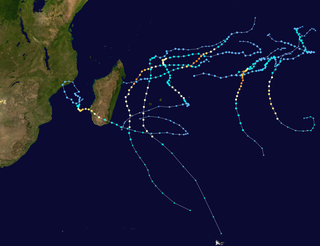
The 2012–13 South-West Indian Ocean cyclone season was a slightly above average event in tropical cyclone formation in the Southern hemisphere tropical cyclone year starting on July 1, 2012, and ending on June 30, 2013. Within this basin, tropical and subtropical disturbances are officially monitored by the Regional Specialised Meteorological Centre on Réunion island, while the Mauritius and Madagascar weather services assign names to significant tropical and subtropical disturbances. The first tropical disturbance of the season developed on October 12 and rapidly developed into the earliest known intense tropical cyclone on record during October 14.

The 2013–14 South-West Indian Ocean cyclone season was an above-average event in tropical cyclone formation. The season officially began on July 1, 2013, though the first tropical system designated by Météo-France was a short-lived tropical disturbance that developed on July 8. However, the first named storm was Cyclone Amara in December. Bruce was the first very intense tropical cyclone since Edzani in 2010, which originated from the Australian region. The strongest system of the cyclone season was Hellen, also one of the most intense tropical cyclones over the Mozambique Channel. The season officially ended on June 30, 2014
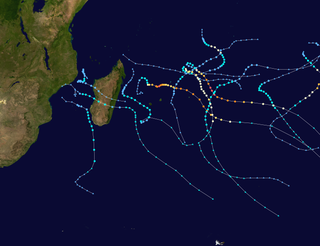
The 2014–15 South-West Indian Ocean cyclone season was an above average event in tropical cyclone formation. It began on November 15, 2014, and ended on April 30, 2015, with the exception for Mauritius and the Seychelles, for which it ended on May 15, 2015. These dates conventionally delimit the period of each year when most tropical and subtropical cyclones form in the basin, which is west of 90°E and south of the Equator. Tropical and subtropical cyclones in this basin are monitored by the Regional Specialised Meteorological Centre in Réunion.

Severe Tropical Storm Delfina was a damaging tropical cyclone that affected southeastern Africa in January 2003. The fourth named storm of the 2002–03 South-West Indian Ocean cyclone season, Delfina formed off the northwest coast of Madagascar on December 30, 2002. It quickly intensified while moving westward, becoming a strong tropical storm before hitting northeastern Mozambique on December 31. Delfina weakened while moving inland, and it was no longer classifiable as a tropical cyclone by January 1, 2003. However, its remnants moved across the country and into Malawi, later looping around and crossing back over Mozambique; the remnants of Delfina were last observed on January 9.
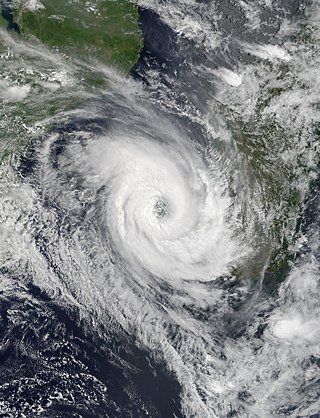
Tropical Cyclone Haruna was a deadly storm that produced widespread flooding and a disease outbreak in southwestern Madagascar. The ninth system of the season, Haruna developed in the Mozambique Channel in the middle of February 2013 between Mozambique and southwestern Madagascar. Initially moving northward over Mozambique, the disturbance later moved slowly southward, gradually strengthening into the eighth named storm of the season and later into an intense tropical cyclone. The Météo-France office in Réunion (MFR) – the official Regional Specialized Meteorological Center in the basin – estimated the cyclone attained peak 10 minute sustained winds of 150 km/h (95 mph). Haruna made landfall near Morombe in southwestern Madagascar on February 22. It weakened significantly while crossing the country, and MFR discontinued advisories on February 24 after the storm had emerged into the Indian Ocean.

Very Intense Tropical Cyclone Hellen of March 2014 was one of the most powerful tropical cyclones in the Mozambique Channel on record, as well as the most intense of the 2013–14 South-West Indian Ocean cyclone season. Hellen formed on March 26 in the northern portion of the channel, and the storm brought rainfall to coastal Mozambique while in its formative stages. While moving southeastward, it developed an organized area of convection over the center of circulation. Warm waters allowed Hellen to rapidly intensify while passing south of the Comoros, with a well-defined eye forming in the middle of the thunderstorms. The cyclone attained peak intensity March 30, with maximum sustained winds estimated 230 km/h (145 mph) according to the Regional Specialized Meteorological Center, Météo-France in La Réunion. Subsequently, Hellen weakened quickly due to dry air and land interaction with Madagascar, and the storm's eye dissipated. On March 31, the storm made landfall in northwestern Madagascar as a weakened cyclone, despite previous forecasts for the center to remain over water. By April 1, Hellen was no longer a tropical cyclone after most of the convection dissipated. The remnants turned to the west, moving over Mozambique without redeveloping, later dissipating on April 5.

Severe Tropical Storm Chedza was a deadly tropical cyclone that struck Madagascar in January 2015. It formed from the Intertropical Convergence Zone and moved over Mozambique, After moving open waters, the system began organizing on January 14, becoming Tropical Storm Chedza two days later. It quickly intensified over the Mozambique Channel due to warm waters and favorable conditions, and the storm attained peak 10 minute sustained winds of 100 km/h (60 mph) on January 16. That day, Chedza moved ashore western Madagascar between Belo sur Mer and Morondava, and it quickly crossed the island while weakening. The storm briefly re-intensified, passing southwest of Réunion before turning to the southeast. Chedza became extratropical on January 19, and was last noted two days later.
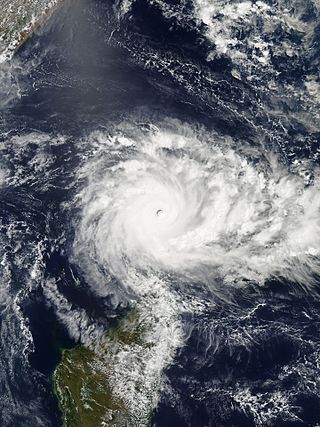
Very Intense Tropical Cyclone Fantala was the most intense tropical cyclone recorded in the South-West Indian Ocean in terms of sustained winds. Part of the 2015–16 cyclone season, Fantala formed on 11 April to the south of Diego Garcia, an island in the central Indian Ocean. With a ridge to the south, the storm moved westward for several days while gaining strength, aided by warm waters and decreasing wind shear. Late on 17 April, the Météo-France office on Réunion (MFR) estimated peak 10-minute winds of 250 km/h (155 mph), making Fantala the strongest tropical cyclone of the basin in terms of 10-minute sustained winds. The Joint Typhoon Warning Center (JTWC) estimated peak 1-minute winds of 285 km/h (180 mph), equivalent to Category 5 intensity on the Saffir-Simpson scale, also the strongest on record in the South-West Indian Ocean, in terms of maximum sustained wind speed. Early on 18 April, Fantala reached its peak intensity, with a minimum central pressure of 910 millibars (27 inHg).

The 2016–17 South-West Indian Ocean cyclone season was a below-average season, with five tropical storms, three of which intensified into tropical cyclones. It officially began on November 15, 2016, and ended on April 30, 2017, with the exception for Mauritius and the Seychelles, for which it ended on May 15, 2017. These dates conventionally delimit the period of each year when most tropical and subtropical cyclones form in the basin, which is west of 90°E and south of the Equator. Tropical and subtropical cyclones in this basin were monitored by the Regional Specialised Meteorological Centre in Réunion, though the Joint Typhoon Warning Center issued unofficial advisories.

The 2018–19 South-West Indian Ocean cyclone season was the costliest and the most active season ever recorded. Additionally, it is also the deadliest cyclone season recorded in the South-West Indian Ocean, surpassing the 1891–92 season in which the 1892 Mauritius cyclone devastated the island of Mauritius, and is mainly due to Cyclone Idai. The season was an event of the annual cycle of tropical cyclone and subtropical cyclone formation in the South-West Indian Ocean basin. It officially began on 15 November 2018, and ended on 30 April 2019, except for Mauritius and the Seychelles, which it ended on 15 May 2019. These dates conventionally delimit the period of each year when most tropical and subtropical cyclones form in the basin, which is west of 90°E and south of the Equator. Tropical and subtropical cyclones in this basin are monitored by the Regional Specialised Meteorological Centre in Réunion.

Intense Tropical Cyclone Idai was one of the worst tropical cyclones on record to affect Africa and the Southern Hemisphere. The long-lived storm caused catastrophic damage, and a humanitarian crisis in Mozambique, Zimbabwe, and Malawi, leaving more than 1,500 people dead and many more missing. Idai is the deadliest tropical cyclone recorded in the South-West Indian Ocean basin. In the Southern Hemisphere, which includes the Australian, South Pacific, and South Atlantic basins, Idai ranks as the second-deadliest tropical cyclone on record. The only system with a higher death toll is the 1973 Flores cyclone that killed 1,650 off the coast of Indonesia.

At least 30 tropical cyclones have affected the Southern African mainland. Three southeastern African countries border the Indian Ocean – Tanzania, Mozambique, and South Africa. Other inland countries also experience the effects of tropical cyclones, including Botswana, Eswatini, Lesotho, Malawi, Namibia, Zambia, and Zimbabwe.

The 2021–22 South-West Indian Ocean cyclone season had the latest start on record. Despite the late start, it was an above-average season that produced 12 named storms, with five becoming tropical cyclones. The season began on 15 November 2021, and ended on 30 April 2022, with the exception for Mauritius and the Seychelles, for which it ended on 15 May 2022. These dates conventionally delimit the period of each year when most tropical and subtropical cyclones form in the basin, which is west of 90°E and south of the Equator. However, tropical cyclones that form at any time between July 1st, 2021 and June 30th, 2022 will count towards the season total. Tropical and subtropical cyclones in this basin are monitored by the Regional Specialised Meteorological Centre in Réunion and unofficially by the Joint Typhoon Warning Center.
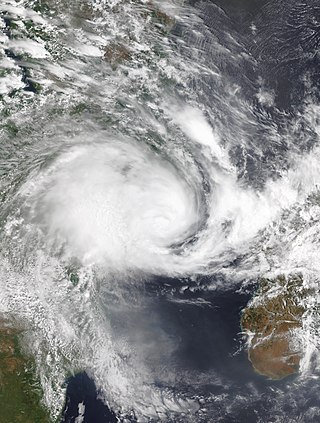
Severe Tropical Storm Ana was a deadly tropical cyclone that affected the African nations of Madagascar, Malawi and Mozambique and was the fourth-deadliest tropical cyclone in 2022, after the Western Pacific Tropical Storm Megi and Tropical Storm Nalgae, and Atlantic Hurricane Ian. The first named storm of the 2021–22 South-West Indian Ocean cyclone season, Ana developed from an area of convection that was designated as Invest 93S northeast of Madagascar.

Intense Tropical Cyclone Batsirai was a deadly tropical cyclone which heavily impacted Madagascar in February 2022, becoming the strongest tropical cyclone to strike Madagascar since Cyclone Enawo in 2017. It made landfall two weeks after Tropical Storm Ana brought deadly floods to the island country in late January. The second tropical disturbance, the first tropical cyclone, and the first intense tropical cyclone of the 2021–22 South-West Indian Ocean cyclone season, Batsirai originated from a tropical disturbance that was first noted on 24 January 2022. It fluctuated in intensity and became a moderate tropical storm on 27 January 2022, after which it unexpectedly rapidly intensified into an intense tropical cyclone. It then weakened and struggled to intensify through the coming days due to present wind shear and dry air, where it weakened after some time. Afterward, it entered much more favorable conditions, rapidly intensified yet again to a high-end Category 4 cyclone on the Saffir–Simpson scale while moving towards Madagascar. The storm underwent an eyewall replacement cycle the next day, and fluctuated in intensity before making landfall in Madagascar as a Category 3 cyclone, later rapidly weakening due to the mountainous terrain on the island.
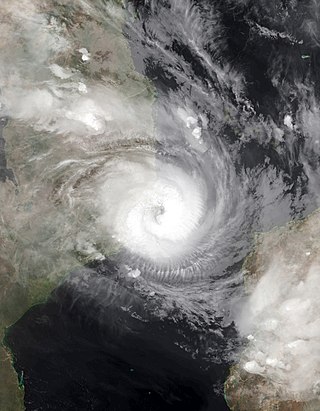
Tropical Cyclone Gombe was a strong tropical cyclone that affected Mozambique. It became the first storm to make a major landfall in Nampula Province in Mozambique since Cyclone Jokwe in 2008. The eighth tropical storm, fourth tropical cyclone and fourth intense tropical cyclone of the 2021–22 South-West Indian Ocean cyclone season, Gombe originated from a tropical disturbance located off the coast of Madagascar. This area of convection was designated by the Joint Typhoon Warning Center as Invest 97S on 6 March. The next day, it began to slowly move westward and executed a loop as it became more organized, which prompted Météo-France Reunion (MFR) to note the system as Zone of Disturbed Weather 09. The system became a depression on 9 March, and became a moderate tropical storm the same day. Soon after being named, Gombe made landfall in Madagascar, and entered in the Mozambique Channel the next day. The storm continued its westward motion while slowly intensifying, and was upgraded to a Tropical Cyclone by the MFR on 10 March. Closing in on Nampula Province, the storm underwent rapid intensification, and was upgraded to the fourth Intense Tropical Cyclone of the year and reached its peak intensity on 11 march, with maximum 10-minute sustained winds of 165 km/h (105 mph), maximum 1-minute sustained winds of 185 km/h (115 mph), and a minimum central pressure of 960 hectopascals (28 inHg). The storm proceeded to make landfall, and quickly lost its convection over land. On 12 March, Gombe degenerated into a remnant low overland. However, the system subsequently turned southeastward and reemerged over water, before briefly regenerating into a tropical depression on 17 March. Gombe dissipated later that day.
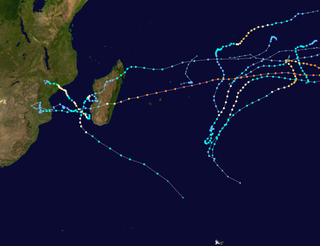
The 2022–23 South-West Indian Ocean cyclone season was one of the costliest and deadliest South-West Indian cyclone seasons on record, mostly due to Cyclone Freddy. It officially began on 15 November 2022, and ended on 30 April 2023, with the exception for Mauritius and the Seychelles, for which it ended on 15 May 2023. These dates conventionally delimit the period of each year when most tropical and subtropical cyclones form in the basin, which is west of 90°E and south of the Equator. However, tropical cyclones can form year-round, and all tropical cyclones that form between 1 July 2022 and 30 June 2023 will be part of the season. Tropical and subtropical cyclones in this basin are monitored by the Regional Specialised Meteorological Centre in Réunion and unofficially by the Joint Typhoon Warning Center. The season was average in terms of the number of systems that formed, with nine systems becoming at least moderate tropical storms, and six reaching tropical cyclone strength. Activity began early, with the first two systems developing in September and October, and ended late with Fabien in May.
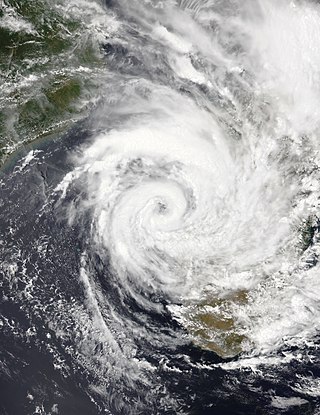
Tropical Cyclone Cheneso was a strong tropical cyclone that affected Madagascar in January 2023. The fourth tropical storm and fifth tropical cyclone of the 2022–23 South-West Indian Ocean cyclone season, Cheneso developed out of a zone of disturbed weather status which was first monitored at RSMC La Réunion on 17 January. Despite convection wrapping into the curved band pattern, the system formed into a tropical depression on 18 January. The depression strengthened into Severe Tropical Storm Cheneso on the following day. Cheneso made landfall over northern Madagascar and weakened into an inland depression, before emerging into the Mozambique Channel. Cheneso later strengthened into a tropical cyclone on 25 January. The system continued moving southeast, before transitioning into a post–tropical depression on 29 January.






















